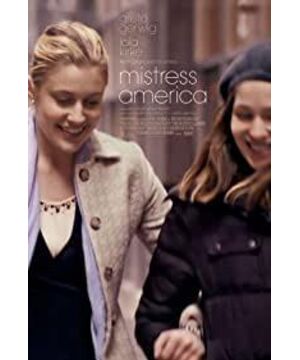To put it simply, this is the story of how the life of Tracy, a lonely college student, was completely changed by Brooke, who was about to become her half-sister.
In addition to this main line, the director also added Tony, a boy who has an ambiguous relationship with Tracy, Nicolette, Tony's girlfriend, Memie-Claire, who broke with Brooke, and Dylan, Brooke's ex-boyfriend and current husband of Memie-Claire. Lots of very interesting characters. In Tracy's view, Brooke is probably what she imagined as New Yorkers. They are enthusiastic, self-confident, and tasteful, and their lives are full of new people and things. The appearance of Brooke not only brings positive signals to Tracy's life; for Tracy who is frowning about writing novels, it is undoubtedly an excellent material. So Tracy fell into Brooke's life and moved it into his novel. This part of the story looks very much like "Entering the Hall" directed by François Ou Jong a few years ago, which interprets the literary story in the film text. Even Tracy's smile and eyes when looking at Brooke are a bit like the little boy in "Into the Hall" when he sees his teacher, with a mysterious meaning that transcends friendship.
But for director Noah Baumbach, of course the script would not be written like this. The preparation for the first 30 minutes is not only to show these vivid characters, but also to elicit the key event in the next hour-Brooke's plan to open a restaurant is facing difficulties because of his boyfriend's divestment. So by chance, or inevitable, Tracy, Brooke, Tony, and Nicolette found Memie-Claire and Dylan, and performed a noisy twists and turns in the latter’s mansion in the wealthy area of Connecticut. Similar performance.
Woody Allen photographed the New York middle class for a lifetime, but he also spent a lifetime mocking or mocking the middle class; Noah Baumbach, who also grew up in New York, aimed at New York’s literary and artistic intellectuals, but he His mockery is more like a kind of self-deprecating and caring, no matter how miserable the process is, it will end up with a faint happy ending. I have seen the director’s previous film "Francis Ha" with a New York background. The audience must have taken it seriously and responded with a gratified smile. For most people, Hollywood-style heroism or success is just a projection of our fantasy. Most of the time, we are like Frances with ideals but nothing. In "American Lover", the director further demonstrated his observation and understanding of middle-class people. We can even think of Brooke in Mistress American as Frances five years later, not only because of the relationship with the same actor Greta Gerweig, but also the images and personalities of the two characters themselves have similarities that cannot be ignored. They were equally chatty, enthusiastic, and smiled brightly, but they were all betrayed and disgraced by their friends. They are by no means the image of traditional movie protagonists, but they are just as straightforward and full of vitality as "Loser". A friend told me that I couldn’t bear watching "Francis Ha" for half an hour, because I felt that I was "worse like a heroine..." Wanting to come to a movie to make people feel this way is also in a sense. Success.
Back to "American Lover". Greta Gerweger not only appeared as the heroine this time, she also wrote the film's script with Baumbach. Therefore, the style of Screwball Comedy presented in this film is also a deliberate attempt by her, and it has been inspired by the works of Howard Hawkes, George Cook and Ernst Liu Biqian from the early and golden age of Hollywood directors. Impact. The most obvious manifestation of these influences is this wonderful group scene in the villa of Brooke's old friends Memie-Claire and Dylan in Connecticut at the end of the film. The main characters in this scene have been foreshadowed, and several groups of characters are connected to each other. Tracy, Tony and Nicolette are in a three-person relationship, Brooke, Memie-Clarie and Dylan are another three-person relationship. Both groups are typical "love triangles," where contradictions erupt in this enclosed space. In addition to this, the detached relationship between Tracy and Brooke is the core narrative motivation of the film. The relationship between Tracy and Brooke, the experience from unfamiliar to familiar, to the rupture in the mansion, and subsequent restoration, constitute the most important narrative clue of the film. Off-line dramas sometimes ignore logic for the sake of a laugh. A mediocre director is considered to have completed the task if he can speak a line; Baumbach-perhaps with the help of Geweig-is a good way to put this The logic of the three lines is smooth, refreshing and natural. And he was even more crazy, joining the two roles of pregnant woman Cindy and neighbor Harold. It looks like an Indian song and dance film, with a steady stream of characters joining, fermenting into a surreal carnival party. And this wonderful atmosphere makes it unobtrusive for the two people who were still "torn" with each other one second to become firm allies in the next second, even with a taste of cold humor.
Like "Francis Ha", the setting of the dual heroines of "American Lover" can not only arouse some discussions about feminism, but also have a more direct impact on the audience by creating two full-figured female characters. . Even across the Pacific Ocean, they are approachable so that you and me in front of the screen can easily be substituted. The 18-year-old girl can see Tracy's sorrow, and the 26-year-old girl who entered the workplace for the first time will also see the shadow of her once in Brooke. Girls and girls see the subtle and delicate feelings, and only the screenwriter Geweig, who is a woman, can understand and express it so accurately. Especially the scene of the last two reconciliation, the few paragraphs, made me very moved. In the final analysis, I just like these arts, loser, and lovely people.
View more about Mistress America reviews











